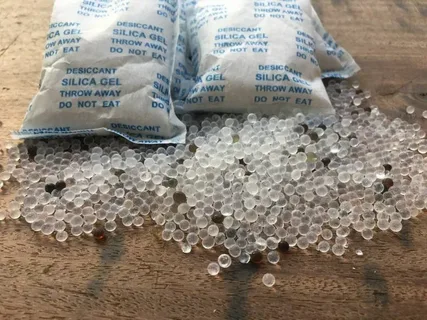Silica Gel Desiccant Guide: Uses & Benefits Explained

Have you ever opened a new pair of shoes or an electronic device to find little packets labeled "Silica-Gel"? You might have wondered what those tiny beads are doing in your packaging. Silica Gel Desiccant are crucial in protecting products from moisture damage, extending their shelf life, and maintaining quality. But there’s so much more to these small sachets than meets the eye. In this guide, we’ll dive deep into the fascinating world of Silica-Gel desiccants. Whether you're looking to understand how they work, discover their various applications, or learn tips for safe handling and reuse, you've come to the right place. Let’s unravel the mystery behind these moisture-absorbing wonders!
What Is Silica-Gel and How Does It Work
Silica-Gel is a granular, porous form of silicon dioxide. Despite its name, it is not a gel but instead tiny beads that absorb moisture from the environment. This makes Silica-Gel an effective desiccant, helping to keep products dry and free from excess humidity.
The magic behind Silica-Gel lies in its structure. The tiny pores within each bead can hold up to 40% of their weight in water vapor. These beads attract and trap moisture when placed in enclosed spaces, preventing damage caused by dampness or mold growth.
You often find Silica-Gel packets in shoe boxes, electronics packaging, or food containers. Their primary function is to maintain optimal conditions for various products by effectively controlling humidity levels.
Common Uses of Silica-Gel Desiccants
Silica-Gel desiccants are versatile tools for moisture control. They’re most commonly found in packaging materials, helping to keep products dry during transit and storage. Whether it’s shoes, electronics, or food items, Silica-Gel packets work quietly behind the scenes to prevent damage from humidity.
These small packets can be placed in closets or drawers to ward off mold and mildew in households. Many use them with important documents or photographs to ensure they remain intact. Their ability to absorb excess moisture makes them ideal for preserving various items around the home.
Industries also rely extensively on Silica-Gel desiccants. Pharmaceuticals and cosmetics help maintain product integrity by preventing spoilage due to dampness. The automotive industry also utilizes these desiccants, protecting sensitive electronic components from corrosion caused by humidity exposure.
Different Types of Silica-Gel and Their Applications
Silica-Gel comes in various forms, each tailored for specific applications. The most common type is the standard Silica-Gel, often found in small packets alongside electronics and food products. Its primary function is moisture absorption, ensuring these items remain dry and safe.
Another variant is orange, which indicates Silica-Gel, which changes color when it's saturated with moisture. This visual cue makes it easier to know when to replace or recharge the desiccant. It's beneficial in environments where monitoring humidity levels is crucial.
Due to its porous structure, activated Silica-Gel has a higher surface area. This feature absorbs more humidity than regular Silica-Gel, making it ideal for specialized industrial applications such as pharmaceuticals and delicate machinery storage. Each type serves a unique purpose, catering to diverse needs across industries.
Benefits of Using Silica-Gel for Moisture Control
Silica-Gel is a remarkable desiccant, prized for its ability to combat moisture-related issues. Its porous structure allows it to adsorb water vapor, preventing damage and degradation in various applications. Understanding its benefits is crucial for effective moisture control.
Prevention of Mold and Mildew
Silica-Gel effectively absorbs excess moisture, creating an environment unfavorable for mold and mildew growth, thus preserving the integrity of stored items.
Protection of Electronics
Sensitive electronic components are susceptible to damage from humidity. Silica-Gel safeguards these devices by maintaining a dry environment, preventing corrosion and malfunctions.
Preservation of Food Items
By absorbing moisture, Silica-Gel extends the shelf life of food products, preventing spoilage and maintaining their quality and freshness.
Safeguarding Valuable Possessions
Items like leather goods, documents, and collectibles are vulnerable to moisture damage. Silica-Gel protects these valuables, preserving their condition for years to come.
Control of Humidity in Enclosed Spaces
Silica-Gel can regulate humidity levels in confined spaces such as storage containers, cabinets, and drawers, ensuring a consistently dry environment.
Proper Storage and Handling of Silica Gel Packets
Proper storage of Silica Gel packets is essential to maintain their effectiveness. Please keep them in a cool, dry place, away from direct sunlight. Exposure to moisture can deactivate the desiccant properties, rendering them less effective over time.
When handling Silica-Gel, avoid breaking open the packets unless necessary. The beads are non-toxic but can pose a choking hazard if ingested, especially for small children and pets. Always supervise when using these products around kids or animals.
If you’re storing Silica-Gel for an extended period, ensure it is sealed in airtight containers. This prevents humidity from seeping in and allows your desiccants to remain ready for action whenever you need them next.
How to Reactivate and Reuse Silica-Gel Desiccants
Reactivating Silica-Gel desiccants is a simple process that can extend their lifespan and save you money. Start by preheating your oven to 250°F (120°C). Spread the used Silica-Gel packets on a baking sheet in a single layer, ensuring they don’t overlap.
Once the oven reaches the desired temperature, place the baking sheet inside for about 1-2 hours. This heat will drive off any moisture the silica beads absorb, restoring their effectiveness. Keep an eye on them to avoid overheating, as prolonged exposure can damage the packets.
After baking, let them cool completely before using them again. Store reactivated packets in an airtight container to keep moisture at bay until you're ready to use them again. Enjoy efficient moisture control without constantly buying new desiccants!
Safety Considerations When Using Silica-Gel
When using Silica-Gel desiccants, remember that they are not edible. Keep them out of the reach of children and pets to prevent accidental ingestion. Although Silica-Gel is generally considered safe, consuming it can lead to gastrointestinal issues.
Store your Silica-Gel packets in a dry place away from moisture sources. Ensure the containers holding these packets are adequately sealed. This prevents unwanted exposure to humidity, which can render the desiccant ineffective.
If you notice any signs of damage or leakage, dispose of the packets immediately. Silica-Gel should be treated with respect and caution like any other household product. Always read labels for specific handling instructions and safety information tailored to particular brands or types of Silica-Gel.
Environmental Impact and Disposal Guidelines
Silica-Gel desiccants are generally considered safe for the environment. They are made from silicon dioxide, a natural substance found in sand and quartz. However, it’s essential to understand how to dispose of used packets properly.
When it comes to disposal, silica-gel is non-toxic but should not be consumed. If you have large quantities, check local regulations regarding industrial waste disposal. For small amounts, throwing them in the trash is typically acceptable.
Depending on your location, recycling options may also exist. Some organizations accept Silica-Gel packets for reuse or recycling programs. Always consider checking with local recycling centers before discarding them carelessly.
Conclusion
Understanding Silica Gel Desiccant opens up a world of effective moisture control. Their unique ability to absorb humidity makes them invaluable in various settings, from preserving delicate items to enhancing product longevity. With proper knowledge about their use, storage, and reactivation methods, you can harness the full potential of these small yet powerful packets. They are an affordable solution for keeping your belongings safe and dry. As awareness grows around sustainability and safety concerns, we must consider how we handle Silica-Gel. By following guidelines for disposal and understanding environmental impacts, we can make informed choices that benefit us and our planet.
FAQs
Silica-Gel desiccants are widely recognized for their moisture-absorbing capabilities, but many still have questions about them. Here are five frequently asked questions that can provide further insight into this versatile product:
What is Silica Gel made of?
Silica Gel is composed of silicon dioxide (SiO2) in a porous form. This structure allows it to absorb moisture effectively.
Can you eat Silica-Gel?
No, Silica-Gel is not safe for consumption. It often comes with the warning “Do not eat,” because while it’s non-toxic, ingesting it could lead to choking or other health issues.
How long does Silica-Gel last?
The lifespan of Silica-Gel depends on the environment it's used in and how much moisture it absorbs. Under optimal conditions, a packet can last several months before needing reactivation.
Is all Silica-Gel the same?
Not all Silica-Gels are created equal. Various types are designed for specific applications—some may be treated with indicators that change color when saturated, while others may contain additives for enhanced performance.
What should I do if my pet consumes Silica-Gel packets?
If your pet ingests a packet of Silica-Gel, monitor them closely and contact your veterinarian immediately. While most types aren’t harmful in small amounts, prompt action is always best to ensure their safety.
Understanding these common inquiries helps demystify what makes Silica-Gel desiccant an essential tool for managing humidity and preserving valuable items.
|
Related Business Listings |






